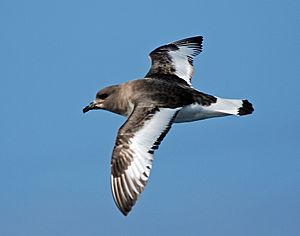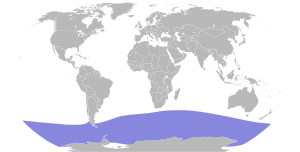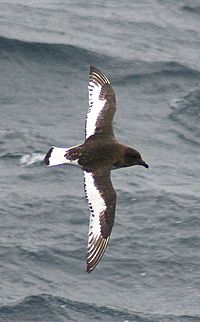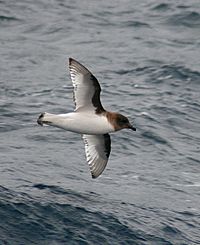Antarctic petrel facts for kids
Quick facts for kids Antarctic petrel |
|
|---|---|
 |
|
| Conservation status | |
| Scientific classification | |
 |
|
| range |
The Antarctic petrel (Thalassoica antarctica) is a type of seabird. It has bold dark brown and white markings. You can find these birds in Antarctica, especially in the Ross and Weddell Seas. They mostly eat tiny krill, fish, and small squid. Antarctic petrels can catch their food while swimming. They can also dive into the water from the surface or from the air.
Contents
Understanding the Antarctic Petrel's Family Tree
How the Antarctic Petrel Got Its Name
Captain James Cook first saw the Antarctic petrel on his second trip to the South Pacific in 1773. Both Cook and a scientist named Georg Forster wrote about this bird. Forster described it as a "new species of petrel, of a brown colour, with a white belly and rump." He also noted a "large white spot on the wings." They named it the Antarctic petrel because they saw many of them in that area.
Later, in 1783, a French expert named Georges-Louis Leclerc, Comte de Buffon included the bird in his book about birds. John Latham also wrote about it. In 1789, a German scientist named Johann Friedrich Gmelin gave the bird its scientific name, Procellaria antarctica.
Today, the Antarctic petrel is the only bird in its group, called Thalassoica. This name was given in 1853 by Ludwig Reichenbach. The name Thalassoica comes from ancient Greek words: thalassa means "sea" and oikos means "house." So, it means "sea house." The word "petrel" comes from St. Peter walking on water. This is because petrels look like they are running on the water when they take off.
Special Features of Petrels
The Antarctic petrel belongs to a bird family called Procellariidae. This family is part of a larger group called Procellariiformes. These birds share some unique features.
First, they have special tubes on their upper bill called naricorns. Their nostrils are on top of their bill. Second, their bills are made of several hard plates, usually seven to nine. One of these plates forms the hooked tip of their upper bill.
Third, these birds can make a special stomach oil. This oil is stored in their stomach. They can spray it out of their mouths to defend themselves from predators. It's also a rich food source for their chicks and for adult birds during long flights.
Finally, they have a salt gland above their nasal passage. This gland helps them remove extra salt from their bodies. They drink a lot of ocean water, so this gland is very important. It releases a salty liquid from their nose.
What Does the Antarctic Petrel Look Like?
Adult Antarctic petrels have a brown head, sides, throat, and back. Their bill is dark brown, and their feet are grey. Their belly and the underside of their wings are white. Their tail and the lower parts of their wings (called secondaries) are white with brown tips.
These birds are medium-sized for a petrel. Their wingspan is about 100 to 110 centimeters (about 3.3 to 3.6 feet). They are about 40 to 45 centimeters (about 1.3 to 1.5 feet) long. On average, they weigh about 675 grams (about 1.5 pounds).
Where Antarctic Petrels Live and Nest
As their name suggests, Antarctic petrels live and breed in the Southern Ocean and on islands around Antarctica. They build their nests on cliffs and rocky areas that are free of snow. These spots can be on the coast or on islands offshore. Some nests have even been found up to 250 kilometers (about 155 miles) inland.
They also often rest on icebergs. During the breeding season, which is from October to November, their nesting colonies can be very large. Some colonies have more than 200,000 pairs of birds!
Sometimes, in late winter, they might fly to Australia or New Zealand. This usually happens if they get caught in a big storm.
Antarctic Petrel Behavior
How Antarctic Petrels Find Food
The main foods for the Antarctic petrel are krill, squid, and small fish. They usually grab their food while floating on the water's surface. However, they can also dive into the water to catch food. They can dive up to 1.5 meters (about 5 feet) deep.
Antarctic Petrel Reproduction and Life Cycle
The Antarctic petrel breeding season happens in October and November. Each pair of birds lays only one egg. Both the male and female bird take turns sitting on the egg to keep it warm. This incubation period lasts for about 45 to 48 days.
After the egg hatches, the chick stays in the nest for another 42 to 47 days. Interestingly, about 4% of breeding pairs are made up of two female birds.
About 70% to 90% of the eggs successfully hatch. The main reasons eggs don't hatch are being eaten by South polar skuas or rolling out of the nest and freezing.
Young Antarctic petrel chicks need their parents for both food and warmth. How healthy the parent bird is affects how much food it gives to its chick. Parents who are in better physical condition are more likely to have a chick that survives. In one experiment, healthy parents were able to give more food to smaller chicks. Chicks can keep themselves warm after about 11 days old.
Antarctic Petrel Conservation Status
The Antarctic petrel lives across a huge area, estimated to be about 77.5 million square kilometers (about 30 million square miles). There are also a lot of these birds, with an estimated 10 to 20 million adults. Because they have such a wide range and so many birds, the International Union for Conservation of Nature has listed them as a species of least concern. This means they are not currently at risk of disappearing.
See also
 In Spanish: Petrel antártico para niños
In Spanish: Petrel antártico para niños




